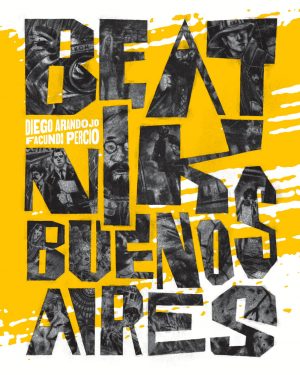Review by Frank Plowright
Jeff Harris is a music journalist working on a book detailing the origins of bossa nova. Just before his first research trip to Brazil he’s captivated by a piece of piano music played by someone he’s never previously heard of, so combines his general research attempting to track down Tenório Júnior. He was playing in Argentina during the years of military dictatorship and disappeared one night. He’s presumed dead.
They Shot the Piano Player superficially occupies similar territory to Chico & Rita, also starting life as an animated film written by Fernando Trueba before he adapted it as a graphic novel with Javier Mariscal overseeing the art. It also deals with music, but this time more directly via including quotes from musicians as if sourced by Harris during interviews. However, this is a very different beast, with the merest of fictional veneers covering a very personal story despite it at first seeming as if Tenório is a fictional construct artfully woven into actual events. The less personal approach is signified by the use of typeset lettering rather than the warmth of a font that looks hand-written.
Taking its lead from the animation, maximum use is made of Brazilian scenery, supplied by Mariscal and assistants with vibrancy and eye-catching colour. As much care is taken in evoking other locations, some more sinister. The sample art contrasts Rio carnival with the subdued atmosphere of Buenos Aires as military rule is imminent in 1976, belying Brazil also under military control. Period evocation is important, as are likenesses, and Mariscal delivers the great and the good of Brazilian music from the 1950s onward with elegant distinction, although there are a few strange anatomical slips such as heads too large for their bodies attracting attention.
Tenório is no fictional implant, and the mystery of his disappearance remains unsolved, while Harris is a stand-in for Trueba who actually conducted the interviews presented after hearing Tenório’s music and becoming fascinated with his story. The result is a form of mystery where Trueba feels a grounding in Brazilian music is necessary, and much of the first third transmits as if Harris is presenting an illustrated lecture. Trueba’s on stronger ground when he has Tenório himself enthusing about music via those who remember him, and an amazingly emotional sequence has a Cuban pianist in New York playing one of Tenório’s compositions from sheet music.
Trueba’s research provides answers, beginning with informed speculation about the appalling Operation Condor, a 1970s alliance between South American dictatorships to eliminate political opposition, greatly helped by the CIA. The most upsetting scenes detail what happened inside torture centres.
Chico & Rita was a universal delight, but this is aimed at a more selective audience. Like Harris, Trueba can’t quite decide whether he wants to focus on the history of Brazilian music from the 1950s or Tenório’s story. In following the latter he feels he has to attribute every observation, which leads to the inclusion of too many people surplus to core events. Anyone fascinated enough by the bigger picture to follow where he leads will, though, meet Argentinian and Brazilian musical legends, and learn how the effects of Tenório’s disappearance rippled ever outward over the years. It’s a loving biography, a mystery and a memorial.
Trueba rounds off the package with his own thoughts, an exhaustive guide to the people Harris interviews and some of Mariscal’s preparatory designs and illustrations.







